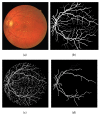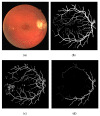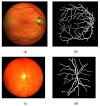Local-Sensitive Connectivity Filter (LS-CF): A Post-Processing Unsupervised Improvement of the Frangi, Hessian and Vesselness Filters for Multimodal Vessel Segmentation
- PMID: 36286385
- PMCID: PMC9604711
- DOI: 10.3390/jimaging8100291
Local-Sensitive Connectivity Filter (LS-CF): A Post-Processing Unsupervised Improvement of the Frangi, Hessian and Vesselness Filters for Multimodal Vessel Segmentation
Abstract
A retinal vessel analysis is a procedure that can be used as an assessment of risks to the eye. This work proposes an unsupervised multimodal approach that improves the response of the Frangi filter, enabling automatic vessel segmentation. We propose a filter that computes pixel-level vessel continuity while introducing a local tolerance heuristic to fill in vessel discontinuities produced by the Frangi response. This proposal, called the local-sensitive connectivity filter (LS-CF), is compared against a naive connectivity filter to the baseline thresholded Frangi filter response and to the naive connectivity filter response in combination with the morphological closing and to the current approaches in the literature. The proposal was able to achieve competitive results in a variety of multimodal datasets. It was robust enough to outperform all the state-of-the-art approaches in the literature for the OSIRIX angiographic dataset in terms of accuracy and 4 out of 5 works in the case of the IOSTAR dataset while also outperforming several works in the case of the DRIVE and STARE datasets and 6 out of 10 in the CHASE-DB dataset. For the CHASE-DB, it also outperformed all the state-of-the-art unsupervised methods.
Keywords: Frangi filter; unsupervised learning; vessel segmentation; vesselness.
Conflict of interest statement
The authors declare no conflict of interest.
Figures













Similar articles
-
Assessment of hessian-based Frangi vesselness filter in optoacoustic imaging.Photoacoustics. 2020 Jul 13;20:100200. doi: 10.1016/j.pacs.2020.100200. eCollection 2020 Dec. Photoacoustics. 2020. PMID: 32714832 Free PMC article.
-
ELEMENT: Multi-Modal Retinal Vessel Segmentation Based on a Coupled Region Growing and Machine Learning Approach.IEEE J Biomed Health Inform. 2020 Dec;24(12):3507-3519. doi: 10.1109/JBHI.2020.2999257. Epub 2020 Dec 4. IEEE J Biomed Health Inform. 2020. PMID: 32750920
-
Supervised retinal vessel segmentation from color fundus images based on matched filtering and AdaBoost classifier.PLoS One. 2017 Dec 11;12(12):e0188939. doi: 10.1371/journal.pone.0188939. eCollection 2017. PLoS One. 2017. PMID: 29228036 Free PMC article.
-
Blood vessel segmentation in color fundus images based on regional and Hessian features.Graefes Arch Clin Exp Ophthalmol. 2017 Aug;255(8):1525-1533. doi: 10.1007/s00417-017-3677-y. Epub 2017 May 4. Graefes Arch Clin Exp Ophthalmol. 2017. PMID: 28474130 Review.
-
Retinal Vessel Segmentation, a Review of Classic and Deep Methods.Ann Biomed Eng. 2022 Oct;50(10):1292-1314. doi: 10.1007/s10439-022-03058-0. Epub 2022 Aug 25. Ann Biomed Eng. 2022. PMID: 36008569 Review.
References
-
- Lamy J., Merveille O., Kerautret B., Passat N., Vacavant A. Vesselness Filters: A Survey with Benchmarks Applied to Liver Imaging; Proceedings of the 25th International Conference on Pattern Recognition (ICPR); Milan, Italy. 10–15 January 2021.
-
- Chaudhuri S., Chatterjee S., Katz N., Nelson M., Goldbaum M. ELEMENT: Multi-modal retinal vessel segmentation based on a coupled region growing and machine learning approach. IEEE J. Biomed. Health Inform. 2020;24:3507–3519. - PubMed
-
- Rodrigues E.O., Conci A., Liatsis P. Morphological classifiers. Pattern Recognit. 2018;84:82–96. doi: 10.1016/j.patcog.2018.06.010. - DOI
LinkOut - more resources
Full Text Sources
Miscellaneous

